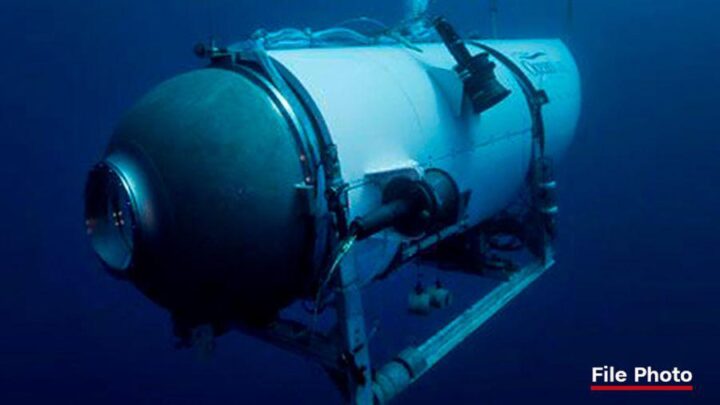This undated photo provided by OceanGate Expeditions in June 2021 shows the company's Titan submersible. OceanGate Expeditions/AP
Rescuers say they have detected banging sounds from the Atlantic Ocean as the frantic search to find a missing submersible continues.
On Sunday morning, a submersible carrying five people began a two-hour descent to see the wreckage of the Titanic at the bottom of the North Atlantic Ocean, nearly 13,000 feet below land, southeast of Newfoundland, Canada.
The eight-day journey conducted by OceanGate Expeditions is priced at $250,000 per person.
About an hour and 45 minutes into its descent, the vessel called Titan lost contact with the Polar Prince, the mothership.
Advertisement
Search operations began later that day but it is still unclear what happened to the submersible, why it lost contact, and how close it was to the Titanic when it went missing.
Coast guard officials say less than a day of breathable air may be left on Titan.
On Wednesday, the officials said a Canadian P-3 aircraft detected underwater noises in the search area, but that efforts to trace the source was unsuccessful.
Advertisement
“Canadian P-3 aircraft detected underwater noises in the search area. As a result, ROV operations were relocated in an attempt to explore the origin of the noises. Those ROV searches have yielded negative results but continue,” the agency tweeted.
“Additionally, the data from the P-3 aircraft has been shared with our U.S. Navy experts for further analysis which will be considered in future search plans.”
Canadian P-3 aircraft detected underwater noises in the search area. As a result, ROV operations were relocated in an attempt to explore the origin of the noises. Those ROV searches have yielded negative results but continue. 1/2
— USCGNortheast (@USCGNortheast) June 21, 2023
Advertisement
So far, three vessels have arrived to join the search for the missing Titan.
One of the vessels, according to the coast guards, has “side scanning sonar capabilities”.
Side scan sonar is a system used for detecting and imaging objects on the seafloor.
Advertisement
PREVIOUS CONCERNS ABOUT TITAN’S SAFETY
According to CNN, David Lochridge, who worked as an independent contractor for OceanGate in 2015 and as its employee between 2016 and 2018, brought up concerns about the Titan’s hull.
Advertisement
Lochridge said no non-destructive testing had been performed on the Titan’s hull to check for “delaminations, porosity and voids of sufficient adhesion of the glue being used”.
He was sued by OceanGate in 2018 for allegedly sharing confidential information.
Advertisement
Two former OceanGate employees also separately raised similar safety concerns about the thickness of the submersible’s hull when they were employed by the company.
In a letter to the company, which the New York Times obtained, safety concerns were also raised by The Manned Underwater Vehicles committee of the Marine Technology Society over what it referred to as the company’s “experimental approach” of the Titan vessel and its planned expedition to the site of the Titanic wreckage.
Advertisement
“Our apprehension is that the current experimental approach adopted by Oceangate could result in negative outcomes, (from minor to catastrophic) that would have serious consequences for everyone in the industry,” the letter partly reads.
“Your marketing material advertises that the TITAN design will meet or exceed the DNV-GL safety standards, yet it does not appear that Oceangate has the intention of following DNV-GL class rules.
“Your representation is, at minimum, misleading to the public and breaches an industry-wide professional code of conduct we all endeavour to uphold.”
Passengers aboard Titan include a British adventurer, a French diver, a Pakistani father and son, and the founder of the tour company.
Add a comment






